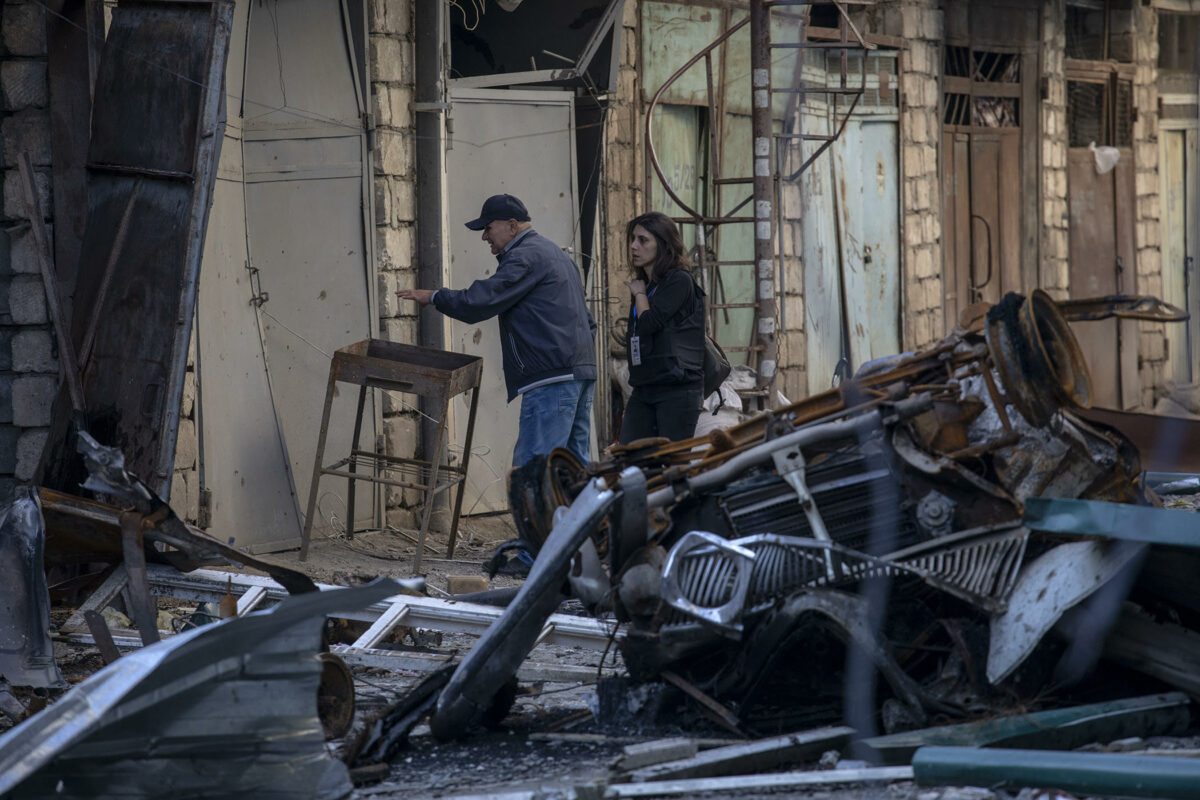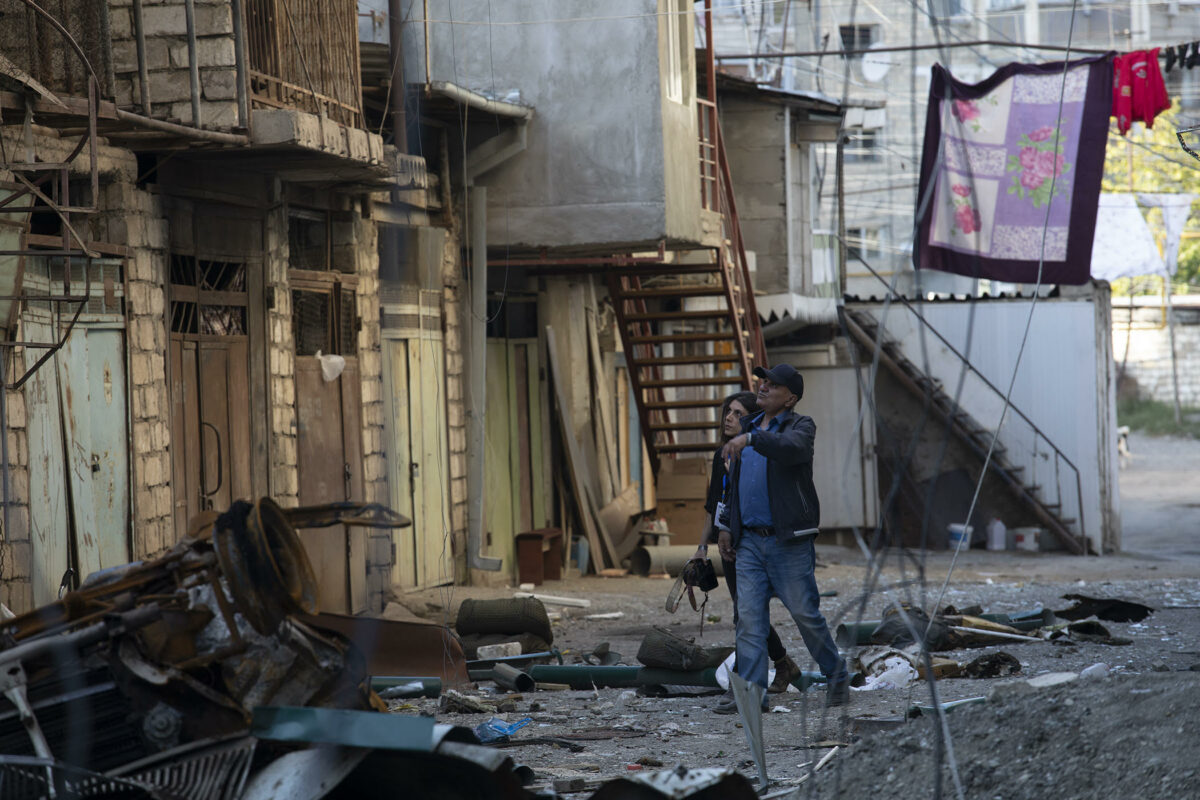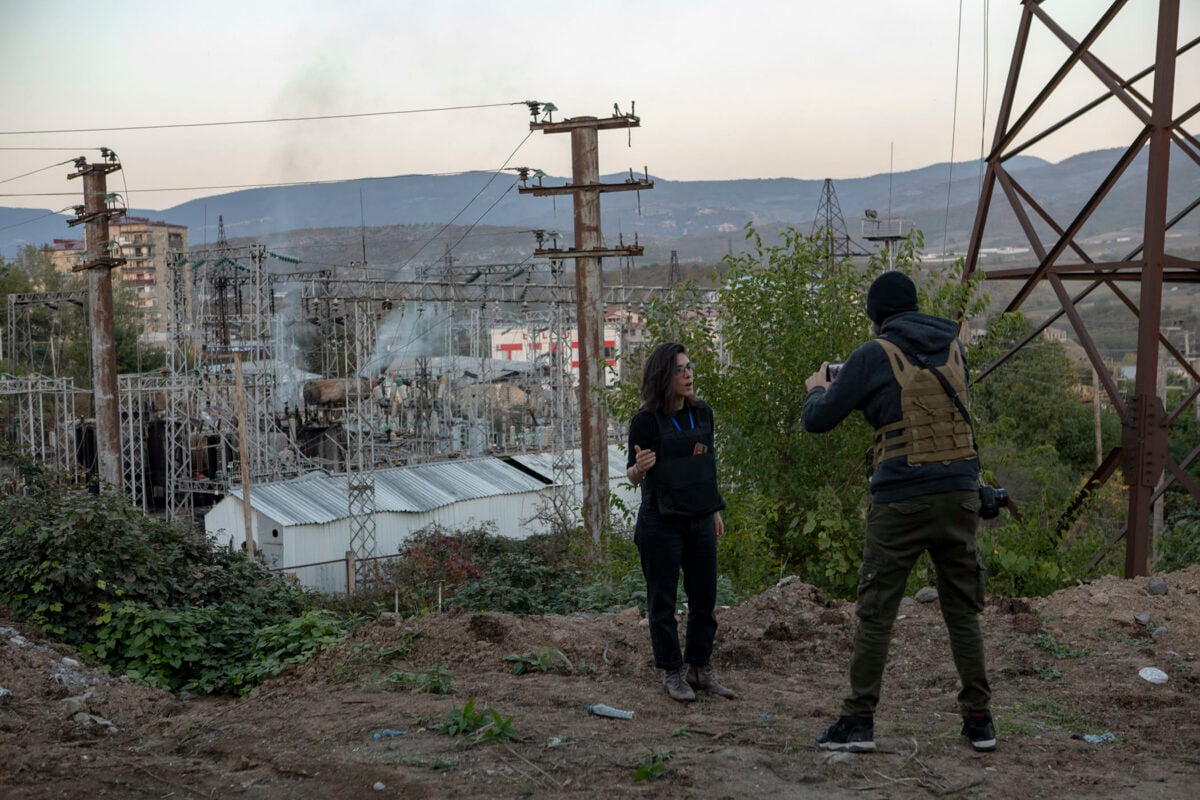EVN Report English-language Armenian media journalist and photographer Roubina Margossian considers being in Artsakh a must for a journalist, saying that journalists not only serve the function of publishing materials quickly but are first and foremost eyewitnesses.
And in this visual age, the job of a journalist is also visual documentation.
According to Roubina, we do not document the Armenian-Azerbaijani war enough because there is not enough trust in journalists.
In martial law, when you are limited to providing only official information, is it important to be in Artsakh?
You should go to Artsakh without a doubt. In my opinion, being in Yerevan now is more strange. And I sometimes do not understand that it is sometimes said that it is courageous to work in Artsakh now, because it is for the peace of mind of the journalist. When you are there, you perceive the situation completely differently, you do not even take it as hard as people who could not do it.
Having a goal and an opportunity to go is already a great advantage, in any circumstance. When you know, you see with your own eyes, it is a completely different feeling. After all, the journalist is an eyewitness.
Of course, there are many problems; the situation changes on the spot, within minutes. For example, what you could do on the first day, you could not do on the fourth day. Especially when the media field is not fair.
In what sense is it not fair?
Naturally, it is a state of war, taking steps is problematic, it is constantly announced, show this, do not show this. As a result, the journalist becomes the enemy of every person who happens to be there. Even when you turn on your camera, someone comes and asks who you are and what right you have here.
Journalists are not given even a small document that would allow them to be sure that we are working in accordance with the law. Armenian journalists have repeatedly asked the Infocenter to provide a piece of paper that would prove that the state is aware that we are here and doing our job.
But there is accreditation.
Only foreign journalists are accredited, but not us. This lack of coordination is very disturbing.
On the one hand, you feel that people have received the message that journalists have become the enemy of the people, especially when you are filming. They can approach and say, “You came to steal information from us and give it to the Turks.” On the other hand, those same people individually want to speak, tell, share with you, without even waiting for you to ask questions. It is such a contradiction.
It’s important for us to be on the scene. And it is unfair when a foreign journalist has the advantage of covering different lines, entering the hospital, the front line. And we can’t do that and don’t know how to obtain that right.
Perhaps we have the impression that if a stranger does it, then the world will see, be informed faster and something will change.
We absolutely do not understand that a stranger will come for a few days, tell a story then leave. And we will give the whole picture, the whole story. One of the fronts of this war is our historical reporting.

On the one hand, they say do not film and do not use pictures, on the other hand, it is clear that images are also weapons. Today the Human Rights Defenders (Artsakh, Armenia), the All-Armenian Fund and various other organizations are asking us to provide them with materials. Images can be a tool for fundraising and fact-finding. But journalists are not being supported.
Sometimes working in such a controversial situation is no longer tolerable! You start to think, if you don’t want any journalists, maybe we shouldn’t come? On the other hand, you realize that we can’t afford not to be there. Even if you return to Yerevan for two days, you know that you will still go back to Artsakh.
Perhaps in this chaotic situation, when the media field is also largely dishonest, is there a risk of information leakage?
After all, if a journalist is filming something, it does not mean that they will publish it. For God’s sake, there are journalists in Armenia who are even more patriotic than a soldier, that is, before publishing something they formulate it a thousand times. Although, of course, there is the opposite.
That is why there are mechanisms that impose an embargo on publications. For example, you can say take a picture, but you do not have the right to publish it now. The job of a journalist is to document.
This is how defense institutions and journalists-documentarians usually cooperate. We ignore all that.
And I sometimes think that we could not do as much as we should have done from the very first days of the war.
What?
For example, the evacuation of Stepanakert. The journalists were told not to try to take pictures because they would know our location and hit us. And at the same time, you see that the BBC is filming there and in their materials, there is not even a quarter of the sensitivity of our local journalists. In other words, the hotel where people move, the bus, the faces are visible in the footage. And that information has already appeared in the international media.
It turns out that we do not have the documentation of one stage of this important story. And when they say tomorrow or the next day, where are the facts of mass evictions due to danger, we will not have them. And what should we do? Ask Reuters for it?
All photos taken by our journalists are now available to various organizations without copyright. Conventional Reuters photos will not be as accessible. Not to mention that they are not ours.
For example, we think a thousand times how to make sure that when we talk about volunteers, the location, the means of transportation, do not appear in the frame, but you are told that you can’t film. And an hour later you see that the same people were photographed and posted on Facebook by the President of Artsakh and that in those photos, everything is visible – the bus, the hotel.
And you ask yourself, you deprived us of our journalistic rights and what happened as a result? It turns out that a whole story was left incomplete.

Doesn’t the state do the documentation? Though, of course, the journalist’s perspective and skills are unique tools.
They do. But I don’t think it is enough, and there is no influence and quality to their images. Sorry, but the photos that are being shared are those of good quality, the information contained in them is not enough on its own.
It is interesting that we always give more importance to foreign specialists and underestimate our own strengths. That must definitely change.
For example, we say with admiration that a World Press Photo award-winning photographer came to Artsakh. But right now, the Armenian photographer who won the same award is in Artsakh, working in much worse conditions than a foreigner, who definitely earns the right to go to the front line.
In short, it is quite a difficult question.
As far as we understand, journalists also use personal connections and their own sources to find themselves at the scene.
Personal connections are important. And the problem is that when journalists feel inactive because they are not allowed to move, they turn to their own sources and go to work. If you try to go through all the obligatory loops, you will end up with the answer “no.” It is easier for everyone to say “no” unequivocally than to trust and cooperate, or to say, let’s do this too. Let’s do it together.
I guess they are not ready to control this large amount of information.
We have no right to be unprepared. There has been a lot of talk and discussion since the April war, and we need to be prepared to gather information.
Of course, you can talk as much as you want to the people in the shelters. But the reality is not just in the shelters, especially now that there are few people in the cities.
Producing materials only in shelters now is like telling the same story over and over again. It makes no sense to tell human stories again for the sixth or sixteenth time anymore!
There comes a time when human stories simply reflect one another.
What is the most influential thing a journalist can do?
Today, the stories we missed are the ones that are most influential and which include the most important parts of the whole story in them: the recruitment of hundreds of volunteers, the evacuation of the people.
Photographer Eric Grigorian and I were in Hadrut for the first few days when a group of volunteers was getting ready to wear military uniforms and leave for the front line. It was a very fragile and powerful moment, they would transform from citizens into soldiers and go to a hotspot. It was a borderline moment for everyone, everyone understood that life had changed and right now they were becoming different people. We filmed that transformation, especially since these guys were asking to be photographed, wanting to get a small distraction from the unknown.
We do not publish it, but it is an important page.
Cities are being emptied today, and we do not have facts about that chain of emptiness. And when we will need them, will we turn to the BBC?
I even thought that if I went to work for a foreign media outlet, I would have a wider opportunity than when I represent the Armenian media. Especially since EVN Report is the only English-language media outlet. And government agencies would benefit greatly by working with us.
Of course, I understand that defense institutions have a lot to do – saying “no” to journalists is a step to get rid of this one concern, but it is not the right solution.
Yes, we see and are proud of the portraits of smiling soldiers that are being spread, but that is only part of the reality.
I say again, let them work, but not tell them not to publish right now. It makes no sense to impose censorship when our self-censorship is thorough enough. And the additional censorship is already causing anger and inefficiency.
As a journalist working in the field, I would, of course, prefer to work at the scene rather than sit in the office and try to be helpful by translating. After all, there are translators better than me, and we journalists have to do documentary work too.
For example, Eric Grigorian’s photos became so widespread that they reached the Human Rights Defender’s Office and were included in reports reporting violations of human rights. It is important …
My stand-ups had a lot of views because they were from the scene and in English. And often we became a source for the international media, they referenced us.
Okay, they do not know us very well, but there are many professional journalists who are unequivocally reliable, they sift through information with a thousand and one internal limitations, and now they tear themselves apart to work.
In any case, we will understand the consequences of these problems later, when the war is over, we will not have enough archives.

For example, we will not have a view of the war like that of Ruben Mangasaryan. And today we remember the war of the 1990s because there were photographers like Mangasaryan at the scene and they validated it every day. And we still use those same photos. And after this war, we will not have such photos. Visual documentation is very important in this visual age.
Of course, there are some things that you should definitely leave to the officials. After all, not everything needs to be fully explored right now.
Armenian journalists are often unfamiliar with the rules of basic physical security. There is little experience with coverage in different hotspots around the world. Does your experience in Beirut help?
Of course, I grew up knowing what shelling was and always being ready to go down to the shelter.
When we talk only about ourselves and only for ourselves, it is also proof of the limitation of our media field. That is a big problem.
Different people can tell the same story and different views will be obtained. The same ruin will have different meanings for different journalists from Stepanakert. There may be an opposite impression, giving the impression that the city is standing or the city no longer exists and has been turned into a pile of stones.
But it is absurd when it is forbidden to film the building of the Stepanakert Civil Hospital. And this is in the case when there is a huge difference between the first days and the current situation. In the early days, it was a normal looking hospital, then the windows were closed with sandbags and the hospital had the appearance of a protected military building. But even photographing it from the outside was forbidden. I have struggled for a long time to make it clear that documenting this is necessary.
It’s clear, isn’t it, that nothing would be decided by my photos, as Azerbaijan has known the location of the hospital and the current appearance of the hospital a long time ago? Were they going to discover this from my picture when there are Google Maps, the hospital website, and aerial photography?
I am not saying that I want to go inside, I want to prove how the situation is changing from the outside. And the moment you are banned from even capturing footage outside, you see foreign journalists coming out from inside, of course, it takes a lot of effort to keep the balance.
We say that there is a need for vetting the judiciary. I am sure that vetting should be done in the media field. There are professionals, people who are needed a lot.
Okay, don’t let me take photos, I am not important at all, but there are definitely journalists who have to do it. And they would do it very well.
And it is interesting that now the professional journalists are more understanding than the state structures are towards them. These barriers could cause a lot of noise, which is not raised by the journalists themselves, who really understand the situation very well. And their work is rarely prioritized. They could do much more than they do.
If we are expected to sit in shelters and not go out, it is a waste of energy.

The international media is ostensibly objective, the official opinions of both sides are simply quoted and thrown into the media, without their own investigations and deep understanding of the situation.
Complete objectivity can’t exist now.
I am lucky that before this war we did a lot of research on the Karabakh movement. And the problem for many young journalists is that they do not have enough information, they get tongue-tied when talking to international experts. For example, the fact that the Karabakh movement gained momentum not because of the events in Sumgait, but because of the trial of the perpetrators of the Sumgait events when the perpetrators were not punished.
It is very important to keep such a chronology in mind so that we are not unaware of the details when speaking, especially with the international media. Let us know that, for example, Azerbaijan renounced its territories in 1923. And Nagorno Karabakh has never been part of independent Azerbaijan.
Now I also do not refuse to comment on the offer of various media outlets.
Though it is very difficult to speak as a journalist in such a way that it does not turn out that you are biased and an activist. Maintaining that balance is absolutely unbearable for me. You grit your teeth and bite your tongue to get your message across.
Interview by Nune Hakhverdyan
Photos by Eric Grigroian







